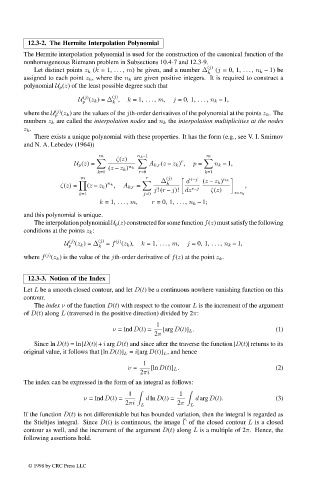Page 623 - Handbook Of Integral Equations
P. 623
12.3-2. The Hermite Interpolation Polynomial
The Hermite interpolation polynomial is used for the construction of the canonical function of the
nonhomogeneous Riemann problem in Subsections 10.4-7 and 12.3-9.
(j)
Let distinct points z k (k =1, ... , m) be given, and a number ∆ (j =0, 1, ... , n k – 1) be
k
assigned to each point z k , where the n k are given positive integers. It is required to construct a
polynomial U p (z) of the least possible degree such that
(j)
(j)
U (z k )= ∆ , k =1, ... , m, j =0, 1, ... , n k – 1,
p
k
(j)
where the U (z k ) are the values of the jth-order derivatives of the polynomial at the points z k . The
p
numbers z k are called the interpolation nodes and n k the interpolation multiplicities at the nodes
z k .
There exists a unique polynomial with these properties. It has the form (e.g., see V. I. Smirnov
and N. A. Lebedev (1964))
m n k –1 m
ζ(z) r
U p (z)= A k,r (z – z k ) , p = n k – 1,
(z – z k ) n k
k=1 r=0 k=1
m r (j) r–j
∆ k d (z – z k ) n k
ζ(z)= (z – z k ) , A k,r = ,
n k
j!(r – j)! dz r–j ζ(z)
k=1 j=0 z=z k
k =1, ... , m, r =0, 1, ... , n k – 1;
and this polynomial is unique.
The interpolation polynomial U p (z) constructed for some function f(z) must satisfy the following
conditions at the points z k :
(j)
(j)
U (z k )= ∆ (j) = f (z k ), k =1, ... , m, j =0, 1, ... , n k – 1,
p k
(j)
where f (z k ) is the value of the jth-order derivative of f(z) at the point z k .
12.3-3. Notion of the Index
Let L be a smooth closed contour, and let D(t) be a continuous nowhere vanishing function on this
contour.
The index ν of the function D(t) with respect to the contour L is the increment of the argument
of D(t) along L (traversed in the positive direction) divided by 2π:
1
ν = Ind D(t)= [arg D(t)] L . (1)
2π
Since ln D(t)=ln |D(t)| + i arg D(t) and since after the traverse the function |D(t)| returns to its
original value, it follows that [ln D(t)] L = i[arg D(t)] L , and hence
1
ν = [ln D(t)] L . (2)
2πi
The index can be expressed in the form of an integral as follows:
1 1
ν = Ind D(t)= d ln D(t)= d arg D(t). (3)
2πi L 2π L
If the function D(t) is not differentiable but has bounded variation, then the integral is regarded as
˘
the Stieltjes integral. Since D(t) is continuous, the image Γ of the closed contour L is a closed
contour as well, and the increment of the argument D(t) along L is a multiple of 2π. Hence, the
following assertions hold.
© 1998 by CRC Press LLC
© 1998 by CRC Press LLC
Page 606

